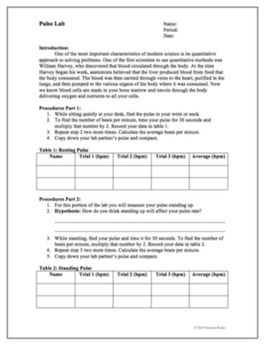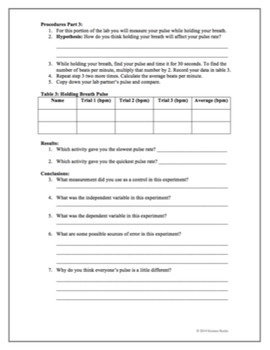Scientific Method Lab Measuring Pulse
- Zip
- Google Apps™

What educators are saying
Also included in
- This unit covers 5 of the human body systems: skeletal, muscular, circulatory, respiratory, and digestive. This product is intended for middle grades. It gives students a good overview of major body organs and how they work, but does not go into detail they will get at the high school level in anatoPrice $44.80Original Price $56.00Save $11.20
- This bundle has everything you need in order to teach and review the scientific method and nature of science to secondary students. You will receive powerpoints, card sorts, labs, writing prompts, worksheets, exit tickets, and a unit test. You can click on each product below to preview.Price $32.40Original Price $41.00Save $8.60
Description
Need a great lab for the beginning of the school year to introduce the scientific method? In this lab students will measure their resting pulse and compare it to their pulse after different levels of physical activity. Included are 2 completely editable versions of the lab- one aimed at middle school students and one for high school students. You will receive both printable PDF versions (to be completed in class with a lab partner) and digital Google slide versions (to be completed at home during distance learning).
You might also be interested in:
Soda Carbonation Experimental Design Lab
3 Hole Bottle Inquiry Experiment- FREE!
Be sure to follow my TpT store by clicking on the green "follow me" next to my seller picture to receive notifications of new products and upcoming sales.
Don't forget to leave feedback to earn TpT credits that can be used for future purchases!
Want free tips and resources sent to your inbox once a week? Subscribe to my newsletter! You can also...
♻️ Check out my blog
♻️ Follow me on facebook
♻️ Follow me on instagram
♻️ Follow me on pinterest






